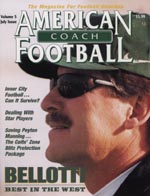Article CategoriesAFM Magazine
|
Attacking the Zone Blitzby: Bruce AriansQuarterback Coach, Indianapolis Colts © More from this issue Every year we all come up with "new" and improved ways to out-attack our opponents. The zone blitz of the 1990s is one such defensive innovation that has created havoc for quarterbacks at all levels. Historically, QBs have been taught to pre-snap read safeties to alert themselves of the potential of a "dog" (LB) or blitz (DB). The difficulty caused by the zone blitz is that effective use of the package does not allow the QB to trust any pre-snap gathering of information by alignment, making him a totally reactive player and essentially putting him on the defensive. Coaches must have excellent research and prep on what our opponents do by formation, tendencies, and personnel. As we prepare our game plans, our job is to arm the QB with the knowledge necessary to "attack the defense," rather than sit back and be attacked. Providing our QBs with a thorough idea of what coverages an opponent's defense will be in, their intentions, and tendencies in specific situations vs. specific formations, is the key to counter-attacking. The following are some examples of zone dogs and blitzes. Offenses during the '70s and '80s had the tendency to free release four or five receivers, with the QB responsible for handling a "hot" LB or DB, and with a sight adjustment by a receiver or a built-in quick receiver route. Too often with the use of the zone blitz, the defense is able to trap the "hot" receiver - exposing the quarterback to being hit hard and often. When an offense free-releases three receivers to the strength of the formation, the defense can create and trap the hot receiver, TE or TB. By showing a two-deep alignment, the QB has no pre-snap read for the two-man blitz or dog. The strong safety (linebacker) takes away the flat-breaking route and the weakside LB runs to the TE look-in route, forcing the QB to throw away the ball or eat it. Vs. the one-back offense with four free receivers, the Cover two zone dog creates a "hot" one side or the other, with a DL and corner trap on the in- or out-breaking receiver. Sometimes the best way to beat a new scheme is to look back at the past. That's where being true students of the game comes into play. We need to re-examine the old playbooks of the '60s and review the plays that called for backs and receivers to "check release" - still allowing the QB five potential receivers, but protecting him from seven defenders. These can be very effective vs. the zone blitz. Offensively, we need to take a look in the past and give the QB protection, then release our five receivers. Once we protect the QB, we can now exploit the big holes in the zone defense. All that is left is deploy your receivers in places that are good vs. the dog or blitz, and, also, will work vs. coverage employed. But that's another story. Remember, never lose the attack mode on offense. P.S. If your QB does not make $48 million, don't forget the lead option. |
|
| HOME |
MAGAZINE |
SUBSCRIBE | ONLINE COLUMNISTS | COACHING VIDEOS |
Copyright 2024, AmericanFootballMonthly.com
All Rights Reserved




